Call us now
- Mon - Sat 7:00 - 16:30, Sunday - CLOSED
- sales@ezshowerrepairandtiling.com

What NOT to Do With A Leaking Shower
What NOT to Do With a Leaking Shower That’s roughly the number of times you enter your shower every year. Shower leaks are among the most common defects found by building inspectors in Australia, which isn’t surprising given the level of water exposure. With over 116 hours of water use annually, effective maintenance and timely repairs are essential. But are you fixing it right? Before you grab that silicone gun or call the first repairman you find, let’s go over what not to do with a leaking shower to avoid common mistakes. Shower Leaks: The 6 Mistakes Costing You a Lot Some common errors that can lead to costly repairs are highlighted below. Read on to learn how to fix a leaking shower the right way. 1. Ignoring Early Warning Signs One of the biggest mistakes homeowners make is delaying action on a leaking shower. The Leaky Shower Timeline When shower leaks are neglected, water damage follows a predictable pattern: Weeks: Water penetrates small grout or sealant cracks, weakening waterproofing layers. Months: Structural components like timber frames begin to rot, and mould grows in damp areas. Year or More: Major upgrades may be needed, including floor repairs and even ceiling collapse. Signs of a Leaking Shower Watch out for these early signs: Mould or mildew in corners and grout lines Loose or broken tiles Peeling paint or wallpaper near the bathroom Persistent musty smells Water stains on nearby walls or flooring 2. Band-Aid Fixes: Why Quick Repairs Can Backfire When noticing a leak, many homeowners attempt quick fixes instead of addressing the root cause. The Silicone Solution Myth Applying silicone along tile joints or fixtures might slow the leak temporarily but won’t repair serious waterproofing issues. Improper use can trap moisture, causing further damage. Skim Coating: A Temporary Fix Applying a thin waterproofing layer over existing tiles (skim coating) may work in specific cases but often fails to address structural movement in your home, leading to recurring leaks. 3. Not Identifying the Real Source of Leaks Visible damage often appears far from the actual source of the leak. The Hidden Nature of Water Damage Water travels the easiest path, so stains or mould may be metres away from the source. Professional leak detection tools like pressure testing and thermal imaging can pinpoint the exact problem. Common Leak Sources Failed waterproofing membranes under tiles Weak grout lines Poorly sealed shower drains Cracks in shower bases or walls 4. Not Removing the Shower Screen This critical mistake is often made by homeowners or repair services looking to cut costs. Why Shower Screen Removal is Essential Shower screens hide key areas where leaks often occur. Penetrations around mounting points and lower edges are common sites of water entry. Proper inspection and repair require removing the screen to access and address these areas. 5. DIY Shower Repair: Good Idea or Bad Idea? While DIY projects can save money, they often lead to bigger problems if done incorrectly. When DIY Works Small issues like replacing showerheads or sealing external joints can be handled by homeowners. When to Call a Professional Water penetration into walls or floors Failed waterproofing Structural repairs Professionals ensure compliance with Australian building codes and use the right materials for long-lasting results. 6. Having Unrealistic Expectations Hoping for a quick, cheap fix can lead to disappointment and frequent repairs. The Reality of Shower Repairs Shower leaks left unaddressed for years often require complete rebuilds to fix hidden damage. While costly upfront, professional repairs with warranties save money in the long term. Final Thoughts: Fixing a Leaking Shower the Right Way To fix a leaking shower properly: Start with professional leak detection to identify the real source of water penetration. Take action early to avoid extensive and costly repairs. Regularly check grout lines and seals to prevent leaks before they escalate. When selecting a repair service, trust specialists like EZ Shower Repair and Tiling. They provide accurate leak detection, expert repairs, and workmanship warranties, ensuring a functional, waterproof bathroom for years to come.

How to Fix a Leaking Shower Floor
How to Fix a Leaking Shower Floor Have you ever experienced a leaking shower at some point in your life? Not only does a leaking shower floor cause disturbance, but if ignored, it can cause water damage, mould growth, and structural problems. In Australia, leaks must be fixed right away because bathrooms are at risk of moisture buildup. Read more of this blog to get a guideline with detailed instructions about how to seal a leaking shower floor. Let’s get started. What Factors are Causing Your Shower Floor to Leak? Shower floors in your bathroom direct water from the shower to the drain. Common causes that can lead to cracks and leaks are: Movement Earthquakes and severe vibrations from machinery can still shift a solid shower floor. Even if it does not crack, shifting it can leave gaps that allow water to pass through. This may happen if the grout crumbles or the floor was not properly slanted when it was installed. Waterproofing Leaks are frequently caused by waterproofing problems, such as wrong product selection, insufficient waterproofing, installation damage, or wrong mixing and application. Poor drainage When the drainage system where the shower drain is located is poorly designed or if there is too much trash in the drain, water can enter between the shower pan and the drain, pool in the surrounding area, and damage the floor. Stone Tiles Stone tiles might gradually deteriorate your shower floors since they absorb large volumes of water like stiff sponges. When shower floors leak, you may search for temporary fixes or delay fixing them. You should decide to fix the leak permanently to save time and money in the long run. Common Signs of a Shower Floor Leak Don’t ignore leaks in your home. Leaks can lead to severe floor damages, and they can affect your bathroom structure. The common signs of leaks to look out for are: Grout or Sealing Problem The grout is broken or missing, or there is no silicone sealant on the joints connecting the walls and floors. Musky Odor If the water can’t dry or get out of the shower area, it can cause mould to grow on shower walls. You can even experience a musky, earthy odour, which usually indicates a leak. Water Stains There are damp patches on the bathroom floor along the walls or outside the shower, and there are water stains on carpets and other surfaces in nearby rooms or at the entrance to the bathroom. Watermarks on the ceiling under the shower indicate a serious leak, especially for bathrooms on the top floor. Check and caulk the shower drain, fill with water, and look for leaks below after 15 minutes. How to Detect the Source of the Leak? It is possible that the shower drain is leaking, but it is also possible that the shower floor is leaking if you notice a stain developing on the shower ceiling or if the flooring next to it is loose or damp. You can identify their exact location by performing the following tests: Spray Test: Apply water to the suspected leak spot and check for leaks after five minutes. Pressure Test: Have a plumber check the pressure in your pipes. Flood Test: Pour water onto the shower floor and block the drain. Keep checking out for leaks. Drain Leak Test: The area between the waste grate and the puddle flange may be the problem if there are no leaks during the flood test but they do during the spray test. How to Seal Leaking Shower Tiles in 6 Steps? So, what can you do about the leaks? We have, in this section, added a step-by-step guideline that you can follow to repair your leaking shower floor. 1. Gather Tools and Materials Shower plug to contain water temporarily. A grout scraper, sponge, caulking gun, and utility knife. Grout for filling gaps between tiles. Sponge and bucket for cleaning. High-quality silicone sealant such as Bostik Ultra Clear or Selleys Ultra to protect tiles and grout. Gloves and safety glasses to protect yourself. 2. Remove Old Grout You don’t need to replace all the tiles, but you do need to remove the old grout. Use a grout removal tool to scrape out old grout, and remove any cracked or loose tiles with a chisel and hammer without damaging the waterproofing membrane. Clean the area thoroughly with a sponge and water, then let it dry completely. 3. Apply a Waterproofing Membrane If waterproofing membrane is not present or damaged, use a new liquid waterproofing membrane with a brush or roller, coating the whole shower floor and going up the walls by a minimum of 150mm for a watertight seal. Dry to the manufacturer’s instructions, since more than one coat may be required. 4. Grouting and Sealing a Shower Use painter’s tape to tape edges to get clean lines. As directed, mix the grout and use a rubber float to spread it. Press firmly into the gaps to eliminate any air pockets. A moist sponge can be used to remove extra grout. 5. Seal Shower Floor Once the grout has set, which usually takes 24 to 48 hours, apply a shower tile sealer to create a water- and stain-resistant layer, especially where the shower floor meets the walls or drain. Apply a thin, even layer of silicone caulk to these spots, smoothing it with your finger or a caulking tool to seal shower floor. 6. Test the Repair You can follow some shower plug instructions to test the bathroom floor for any leakage. Do the following: Get a plug: Block the drain with a shower plug. Push-fit plugs are designed to fit over waste pipes, whereas rubber suction plugs are suitable for flat drains. Insert carefully: Press firmly until no more space is left. Look for leaks: Fill the shower base with a few inches of water, let it sit for 15-20 minutes, then check for any signs of leakage. If the floor remains dry, your repair was successful.
